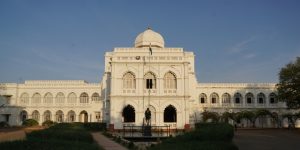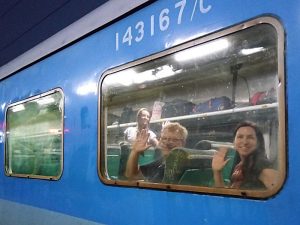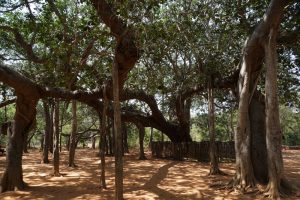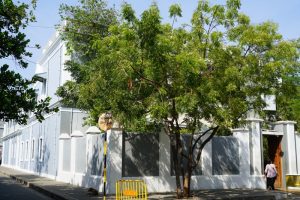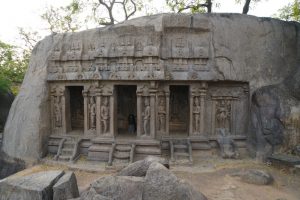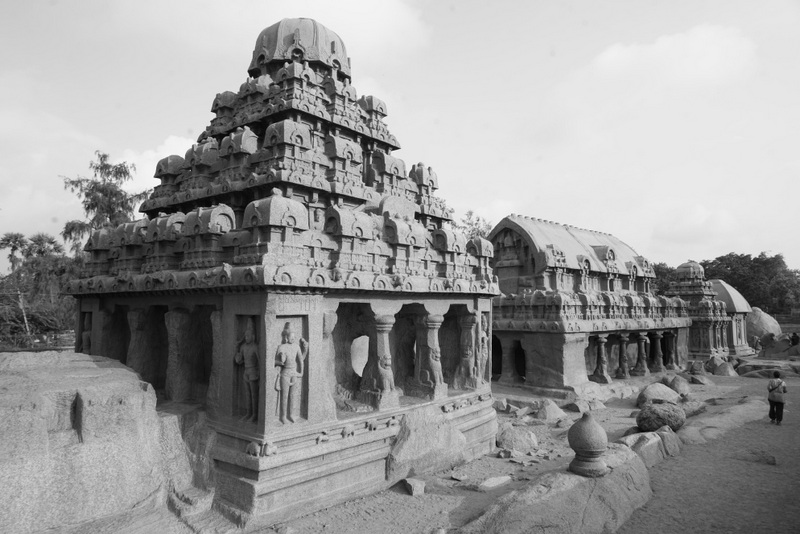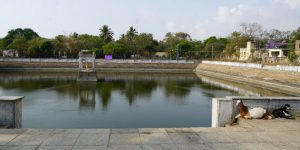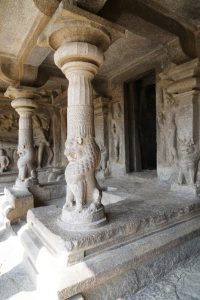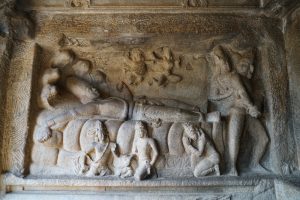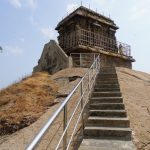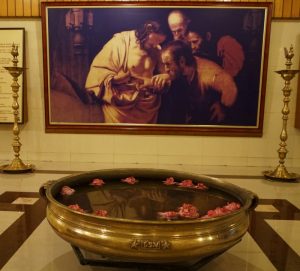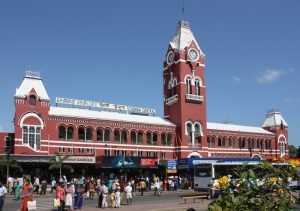Tamil Nadu: Madurai, Mamallapuram, Pondicherry & Chennai March 5 – 8
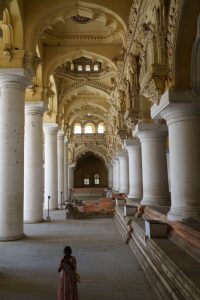 We had a leisure day and did not start till 10 am. Muthu’s original plan was to take us to the Meenakshi Amman Temple in the morning followed by a visit to the Gandhi Museum. When I indicated my interest to visit the Thirumalai Nayak Palace and others expressed an interest to go, Muthu decided to change the programme and began our guided tour at the palace.
We had a leisure day and did not start till 10 am. Muthu’s original plan was to take us to the Meenakshi Amman Temple in the morning followed by a visit to the Gandhi Museum. When I indicated my interest to visit the Thirumalai Nayak Palace and others expressed an interest to go, Muthu decided to change the programme and began our guided tour at the palace.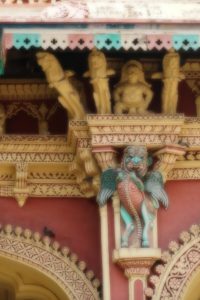
It was close to 11 am when we met our guide at the Thirumalai Nayak Palace. We paid for our own ticket (R30) as it was not part of the original programme. The palace erected in 1636 by King Thirumalai Nayak of the Nayaka dynasty (1545 – 1740s) who ruled from 1623 – 59. Designed by an Italian architect, the palace is a classic fusion of Dravidian and Rajput styles. In its heyday, it was considered to be one of the wonders of the South. Today, less than a quarter of the palace remains.
 After entering the Entrance Gate, I was amazed to find a most beautiful and well-proportioned central courtyard measuring 3,700m2 and surrounded by massive 13m-high circular pillars.
After entering the Entrance Gate, I was amazed to find a most beautiful and well-proportioned central courtyard measuring 3,700m2 and surrounded by massive 13m-high circular pillars.
At the end of the courtyard is the Main Hall. The structure was constructed using foliated brickwork and the surface details and finish in exquisite stucco called chunnam using chunnam (shell lime) and mixed with egg white to obtain a smooth and glossy texture. The steps leading up to the hall were formerly flanked by two equestrian statues of excellent workmanship.
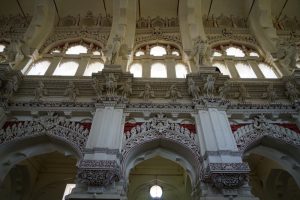 The Celestial Pavilion used as the throne-room has an arcaded octagon covered by a dome of 60-70 ft high. A replica of the throne is placed under the dome while the real one is in the British Museum.
The Celestial Pavilion used as the throne-room has an arcaded octagon covered by a dome of 60-70 ft high. A replica of the throne is placed under the dome while the real one is in the British Museum.
The pillars supporting the arches are joined by foliated brickwork that carries a valance and an entablature rising up to a height of 20 m. The pavilions topped with finials covered with gold are on either side of the courtyard.
Then a doorway at the right-hand corner took us to the Dance Hall which now serves as a museum with sculptures, earthen wares etc. The hall exquisitely and beautifully decorated in yellow and white looks European with a feel of the interior of a church.
I could easily spend another 30 minutes in the palace. But the guide urged us to leave as the temple would be closing at 1 pm. We had a 2-km rickshaw ride to the temple. It was close to noon when we began our temple tour.
The Meenakshi Amman Temple located on the southern bank of the Vaigai River, is dedicated to Meenakshi (a form of Parvati), a consort of Sundareshwar (a form of Shiva). It is one of the major Hindu temples dedicated to Meenakshi and a major pilgrimage destination within the Shaivism tradition.
 Originally built by the early Pandyas (7th – 10th centuries), most of the structures were destroyed by the Muslim Delhi Sultanate rebuilt around the 14th century AD. It was rebuilt and reopened by the Vijayanagara rulers and further repaired, renovated and expanded by Thirumalai Nayak in the 17th century. It is considered to be the finest in South Indian religious architecture.
Originally built by the early Pandyas (7th – 10th centuries), most of the structures were destroyed by the Muslim Delhi Sultanate rebuilt around the 14th century AD. It was rebuilt and reopened by the Vijayanagara rulers and further repaired, renovated and expanded by Thirumalai Nayak in the 17th century. It is considered to be the finest in South Indian religious architecture.
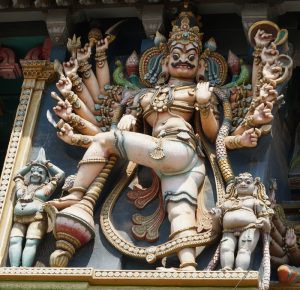
 The complex is within a high-walled enclosure, at the core of which are the sanctums for Meenakshi and Sundareshwar, surrounded by a number of smaller shrines and grand sculptured pillared halls. Some of the shrines are dedicated to other Hindu deities including Vishnu and wife Lakshmi, Brahma and Saraswati, Krishna etc.
The complex is within a high-walled enclosure, at the core of which are the sanctums for Meenakshi and Sundareshwar, surrounded by a number of smaller shrines and grand sculptured pillared halls. Some of the shrines are dedicated to other Hindu deities including Vishnu and wife Lakshmi, Brahma and Saraswati, Krishna etc.
 The temple is famous for its gopuras (monumental gateways) which rise to 45-50m high and are covered with stucco figures of deities, mythical animals, and monsters all painted in vivid colours. The Chitra Gopura, the seven-storeyed gopura at the southern side is the tallest standing at 51.9m.
The temple is famous for its gopuras (monumental gateways) which rise to 45-50m high and are covered with stucco figures of deities, mythical animals, and monsters all painted in vivid colours. The Chitra Gopura, the seven-storeyed gopura at the southern side is the tallest standing at 51.9m.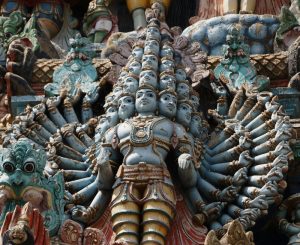
We entered the complex from the northern entrance and sat by the Potramarai Kulam (or ‘Golden Lotus” Tank) for a briefing. The tank is surrounded by pillared corridors with the Chitra in the background.
We walked past the Meenakshi Shrine and watched pilgrims entering the sanctum. As we are not Hindu, we cannot enter. Every evening before the closing of the temple, a ritual procession led by drummers and a brass ensemble carries the image of Sundareswarar here to Meenakshi’s shrine. In the morning, his image is bought back to his own shrine.
After wandering through many pillar galleries, I noticed we walked past the thousand Pillar Hall on the way to the Kalyana Mandapa. I thought our guide would bring us back to this hall later.
We stopped for a while in the Kalyana Mandapa to admire a masterpiece of sculpture Kalyana Sundara showing Vishnu giving Meenakshi to Sundareswarar.
Then we arrived at the 16th century Kambattadi Manapa next to the Sundareshvara’s shrine. In front of the shrine is a remarkable pavilion with a seated Nandi, Shiva’s vehicle.
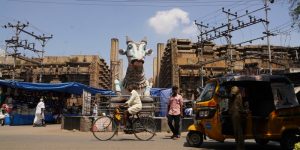
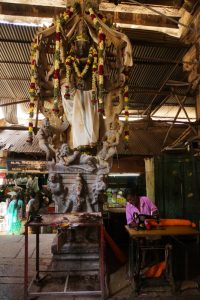 By the time we came out, it was well after 1 pm. But we had not visited the Thousand Pillar Temple which is also a museum. When we discovered the temple would reopen at 3 pm (instead of 4 pm), we decided to return. We had an hour and a half strolling around the temple complex looking at markets and taking photos of the gopuras from the outside.
By the time we came out, it was well after 1 pm. But we had not visited the Thousand Pillar Temple which is also a museum. When we discovered the temple would reopen at 3 pm (instead of 4 pm), we decided to return. We had an hour and a half strolling around the temple complex looking at markets and taking photos of the gopuras from the outside.
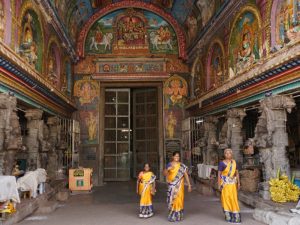 Time passed quickly. We went in again at 3 pm. Some staff told us the Thousand Pillar Temple would only open at 4 pm. Indian are good at information technology. But information is often unclear and confusing. Anyway, we were delighted to find the temple-museum open.
Time passed quickly. We went in again at 3 pm. Some staff told us the Thousand Pillar Temple would only open at 4 pm. Indian are good at information technology. But information is often unclear and confusing. Anyway, we were delighted to find the temple-museum open.
The Thousand Pillar Temple with 985 beautifully decorated pillars dating to the 16th century, is worth visiting. Though the pillars are not as large and tall as those in other temples, the sheer number and density of the pillars create a unique atmosphere. The central path lined with sculptured pillars with animals are splendid.
It was after 4 pm when we made our way to the exit. All except me decided to return to the hotel. I took a tuk tuk (R120) to the Gandhi Museum. There are two main sections in the museum: one on India’s struggle for freedom and the other on the life and the role played by Mahatma Gandhi (1869-1948), the nation’s father during the struggle.
There are over 20 panels with loads of information, historical photos and relics of Gandhi. The most memorable item is the blood-stained dhoti he wore on the day of his assassination on January 30, 1948. I guess it is symbolic: Gandhi initiated the charkha movement and on his first visit to Madurai in 1921, he began wearing the traditional Indian dhoti and shawl woven with yarn hand-spun on a charkha.
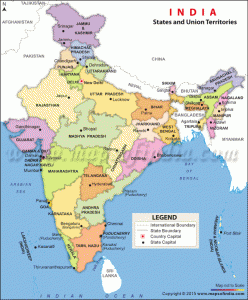 I was glad to find a vegetarian restaurant with an outdoor food stand opposite the museum. I ordered fried noodles (R50) and was surprised at the small portion. I was still hungry and grabbed a samosa and a cup of marsala tea at the food stand. The locals cast an amazing glance at me as I was the only non-Indian customer in the crowd. I paid R68 for my meal or rather snack. I guess I can spend less than R300 on food a day if I eat like a local!
I was glad to find a vegetarian restaurant with an outdoor food stand opposite the museum. I ordered fried noodles (R50) and was surprised at the small portion. I was still hungry and grabbed a samosa and a cup of marsala tea at the food stand. The locals cast an amazing glance at me as I was the only non-Indian customer in the crowd. I paid R68 for my meal or rather snack. I guess I can spend less than R300 on food a day if I eat like a local!
I took a tuk tuk to the hotel which is not far from the museum. The driver does not speak English. I showed him the hotel card mentioning the name of the bus stand/terminal. He nodded. But when I noticed he was driving back to the city centre, I immediately pointed him at the opposite direction. He turned his head and seemed to understand. Anyway, he drove towards the city centre before stopping the vehicle to ask his friends. He shrugged his head when he realised he had gone the wrong way. He spent another 25 minutes taking me back to my hotel. I felt bad and gave him R100 instead of R60 as agreed. It was 7 pm when I was back in my room.
I had a tiring day. According to the itinerary, the temple and a rickshaw ride were included. When Muthu learnt about our interest in the palace, he arranged the guide to take us to see the palace before the temple. As a result, we did not have enough time for both as we had a late start. With better communication and an earlier start, we could have had time for both attractions in the morning. Then we would have a leisure afternoon to explore the city and other attractions.
Day 6 Wednesday: Madurai – Mamallapuram
We left the hotel at 5:15 am and took the Vaigai Express at 7 am to Chengalpattu. It’s a pleasant ride. For the first time, I could see through the window as it was not covered in dust. Pollution does not seem to be a problem in the south: lovely clouds livened up the blue sky. The countryside is lush green covered with expansive paddy fields. Some fields which have been harvested or ready for harvest, are golden in colour. The railway stations our train sped through looked surprisingly clean and tidy.
We got off the train just before 1:30 pm. Muthu arranged a minibus with air-con (for the first time) to take us to Mamallapuram, a fishing village.
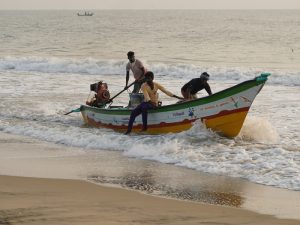 We had a pleasant 40-minute ride. On the way, Muthu proposed and the group agreed to have a free afternoon today followed by a free day the next day. He would arrange a guided tour on Day 8 before leaving for Chennai. Perfect!
We had a pleasant 40-minute ride. On the way, Muthu proposed and the group agreed to have a free afternoon today followed by a free day the next day. He would arrange a guided tour on Day 8 before leaving for Chennai. Perfect!
After checking in the Mamalla Inn, all of us except Pesa went to Santana for a late lunch. We had panoramic views of the Mamalla Beach dotted with fishing boats. I ordered grilled king prawn served with fried rice for R500. I shared a 650ml-bottle beer with Brenda (R300): this was my first taste of beer on this trip.
Muthu suggested me find a travel agent here to get my train ticket to Darjeeling. There are many travel agents on the main street. But only one was helpful. After checking train schedule and seat availability, the boss suggested me take a day train on March 14 to New Jalpaiguri (NJP) and the toy-train to Darjeeling (DJ) the next day. His staff tried twice to book the NJP-DJ section without success. He suggested me come back later.
I caught a glimpse of the setting sun around 6 pm from the rooftop. I had time for a stroll to the beach before it got dark. I passed by the Shore Temple and found local tourists standing on the beach. It’s the Indian way to enjoy the beach!
It was dark now. I returned to the same travel agent. The boss spent another hour and a half to sort out my ticket. While my ticket from Kolkata to NJP (561km) was issued without problem, he failed twice to issue the ticket for NJP – DJ. But he discovered from his company account that he had been charged three times. (I hope he can get his money back). Finally, he gave up and just handed me the ticket for a chair in an air-con carriage (R1360) on March 14. Eventually I paid R1500 for the ticket and his service.
I skipped dinner as I had a big lunch around 4 pm. I went to bed early and had an excellent sleep. But poor Carla had a sleepless night.
Day 7 Thursday: Auroville & Puducherry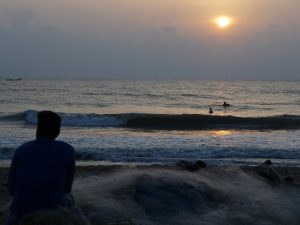
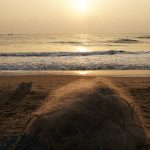 I got up just before 6 am and went to the rooftop to see whether the sun had risen. It was already hiding behind clouds. I went to the beach anyway. When I got there, the sun just broke through the clouds. I had a nice time watching the fishermen getting ready for fishing with the rising sun at the background. Fantastic!
I got up just before 6 am and went to the rooftop to see whether the sun had risen. It was already hiding behind clouds. I went to the beach anyway. When I got there, the sun just broke through the clouds. I had a nice time watching the fishermen getting ready for fishing with the rising sun at the background. Fantastic!
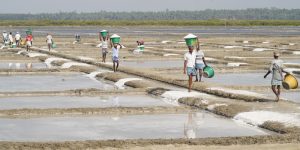 I had an excellent ginger marsala tea (R10) and a cookie (R20) for breakfast at a tea stall near the beach. At 8:30 am, Carla, Mike and I set off in a private car to Puducherry (R4500 for a car) which is about 70km south of Mamallapuram.
I had an excellent ginger marsala tea (R10) and a cookie (R20) for breakfast at a tea stall near the beach. At 8:30 am, Carla, Mike and I set off in a private car to Puducherry (R4500 for a car) which is about 70km south of Mamallapuram.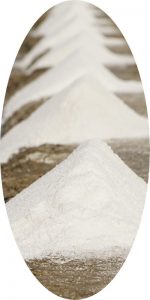
We had a comfortable ride. The road is paved and in good condition. We stopped at a salt pan to watch workers carrying buckets of salt on their head to a depot.
Our second stop was Auroville (or known as “City of Dawn”) which is about 8 km northwest of Pondicherry. We arrived shortly after 10 am and planned to stay an hour. We had an amazing time and did not leave till 12:15 pm!
Auroville, the brain child of The Mother, Mirra Alfassa (1878-1973), a Parisian mystic, painter and musician, a disciple and spiritual partner of Sri Aurobindo Ghose (1872-1950). It has been planned as a futuristic international city where people with good will would live together in peace.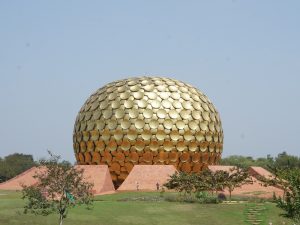
The place was a barren plateau of largely red earth at its inauguration ceremony held on February 28, 1968. Representatives of 124 countries and 23 Indian states placed a handful of earth from their homelands in a lotus-shaped urn at the centre of the future township in a symbolic gesture of human unity.
Designed by French architect Roger Anger, Auroville today is lush green, leafy and cool, a world of its own. The 2,800 permanent residents from India and 54 countries are engaged in a wide range of activities including research into a cashless economy, environmental regeneration, organic farming, renewable energy, handicrafts etc.
All visitors are advised to watch a video on the origin and design plan for this utopian community on arrival. We watched the video and spent a while in the interpretation centre. Then we had a nice cup of tea and a piece of cake before embarking on a 1km-long stroll to the viewing platform for Matri Mandir, the spiritual and physical centre of Auroville.
Set in an area of 25 ha, the golden Matri Mandir captures visitors’ attention as well as imagination. A crystal is placed inside this spherical marble chamber, reflecting the sun’s rays: the concentrated light acts as a focal point to aid meditation. I love to return one day to meditate and embark on a spiritual journey!
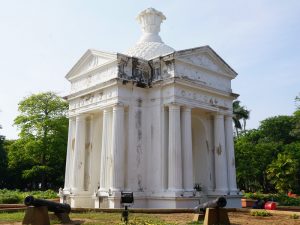 It did not take long to drive to Puducherry (formerly known as Pondicherry), the former capital of French territories in India. It was transferred to India in November 1954 and is now a union territory of India.
It did not take long to drive to Puducherry (formerly known as Pondicherry), the former capital of French territories in India. It was transferred to India in November 1954 and is now a union territory of India.
Established in 1674 by Franciǫs Martin (the first director of the French Indian Company), the French Quarter of Puducherry was laid out in a grid pattern with five parallel streets cutting across each other at right angles. It is bounded by a canal (now covered) in the north and a 3km-long promenade running along the Bay of Bengal with the statue of Mahatma Gandhi in the middle.
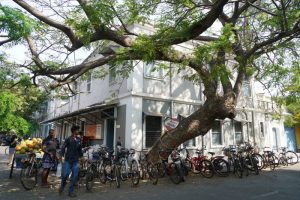 This small area is charming and atmospheric with elegant colonial mansions, tree-lined boulevards, parks, bars and cafes. Many of the restored mansions along the promenade have now been turned into boutique hotels.
This small area is charming and atmospheric with elegant colonial mansions, tree-lined boulevards, parks, bars and cafes. Many of the restored mansions along the promenade have now been turned into boutique hotels.
At our request, our driver gave us a quick city tour of the White Town and the local district. We found ourselves traversing two different worlds within minutes.
At the end of the promenade, we turned right and soon saw the nostalgic yellow train station. Close by is the Basilica of the Sacred Heart of Jesus consecrated in 1907. At the end of the drive, our driver dropped us near the Manakula Vinayakar Temple where we would meet at 4:30 pm.
We felt tired and exhausted. As the Aurobindo Ashram would be close till 2 pm, we had a good excuse for a rest. While Mike and Carla were having coffee and French pastry in a café, I had a 650ml-bottle of beer and chicken biryani for R310.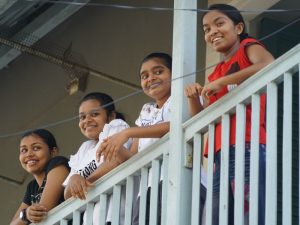
After lunch, we returned to the Aurobindo Ashram which was established by Sri Aurobindo Ghose and The Mother in 1926. Aurobindo, a Bengali poet-philosopher, joined the struggle for freedom in 1900s. He escaped the British rule and took refuge in the French territory where he studied, wrote and popularised the principles of yoga. Today, the ashram is the city’s best -known land mark. I first heard about this ashram when I met a French couple in Munnar.
The ashram is a peaceful retreat with tree-shaded courtyards. A memorial of Sri Aurobindo and The Mother lies under a frangipani tree. We sat in silence for five minutes in the courtyard. I bought a book on The Mother in order to learn something about this extraordinary lady.
 We strolled along the promenade with a photo stop at the Gandhi statue. We returned to the leafy Government Square with a pavilion in its centre. We visited the Immaculate Conception Cathedral.
We strolled along the promenade with a photo stop at the Gandhi statue. We returned to the leafy Government Square with a pavilion in its centre. We visited the Immaculate Conception Cathedral.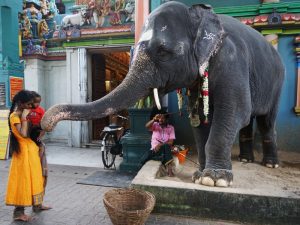
We returned to the Manakula Vinayakar Temple dedicated to Ganesha. The elephant stands outside the temple after 4 pm to bless visitors. It touches the head of visitors and happily takes money from donors and passes it to its keeper.
We headed back to Mamallapuram at 4:30 pm. On the way, we watched a beautiful sunset. I skipped dinner as I already had a big lunch. I had a lovely and enjoyable day!
Day 8 Friday: Mamallapuram – Chennai
Mamallapuram was one of two major port cities by the 7th century within the Pallava kingdom (3rd – 9th centuries AD) which ruled from Kanchipuram. The city of Mamallapuram was founded by Narasimhavarman in the 7th century AD. It became a centre of a group of monuments carved out of rock including marathas (temples in the form of chariots), mandaps (cave sanctuaries), giant open-air rock reliefs and shore temple. What makes Mamallapuram so culturally resonant are the influences it absorbs and disseminates. These monuments are now World Heritage Properties.
To escape the heat, our tour with a local guide began at 6:30 am.
First, the Arjuna’s Penance (or Descent of the Ganges. There are numerous completed and uncompleted cave temples and monolithic temples mostly built during the Pallava Period in the park.
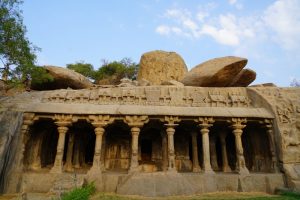 We followed our guide to see the Krishna’s Butter Ball, the Ganesha Ratha, the Trimurti Cave Temple dedicated to Vishnu, Shiva and Brahma built between 695 and 722 AD (right to left), a round rock-bath, the Varaha Cave Temple and an unfinished Panch Pandava Cave Temple.
We followed our guide to see the Krishna’s Butter Ball, the Ganesha Ratha, the Trimurti Cave Temple dedicated to Vishnu, Shiva and Brahma built between 695 and 722 AD (right to left), a round rock-bath, the Varaha Cave Temple and an unfinished Panch Pandava Cave Temple.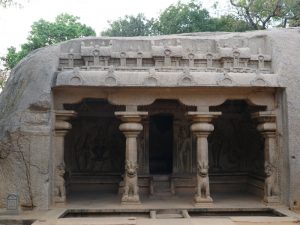

Second, the Pancha Rathas (Five Chariots) comprising five monolithic pyramidal structures resembling processional chariots.
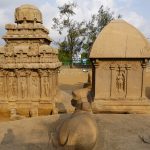
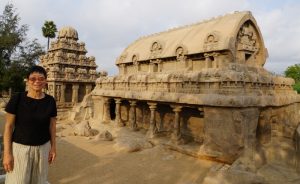 Hewn from the granite rock face built between 630 and 668 AD, the structures are named after the Pancha Pandavas of epic Mahabharata fame (Arjuna, Bhima, Yudhishtra, Nakula and Sahadeva) and their common wife Draupadi.
Hewn from the granite rock face built between 630 and 668 AD, the structures are named after the Pancha Pandavas of epic Mahabharata fame (Arjuna, Bhima, Yudhishtra, Nakula and Sahadeva) and their common wife Draupadi.
The Bhima ratha is the longest with a length of 12.8m while Yudhishtra is the tallest. The mandapa viharas with halls and stone roofs with narratives from the Mahabharata, Shaktism and Vaishnavism.
These monolith processional chariots were never completed following the death of Narasimhavarman.
Third, the Rock-cut Shore Temple one of the oldest structural (versus rock-cut) stone temple.
 Made of granite, this monument is a twin-temple dedicated both to Vishnu and Shiva. Built in 700-728 AD from a dressed stone overlooking the shore of the Bay of Bengal, it appears like a pagoda and has many reliefs, including one 100-ft long and 45-ft high, carved out of granite.
Made of granite, this monument is a twin-temple dedicated both to Vishnu and Shiva. Built in 700-728 AD from a dressed stone overlooking the shore of the Bay of Bengal, it appears like a pagoda and has many reliefs, including one 100-ft long and 45-ft high, carved out of granite.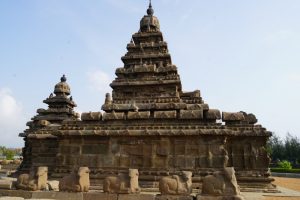
It is now inferred that this temple complex was the last in a series of Seven Pagodas described in the diaries of Europeans that seemed to exist in the submerged coastline. This is supported by the appearance of an outline of its sister temples off the coast during the tsunami of December 2004. The architecture of the Shore Temple was continued by the Cholas who defeated the Pallavas.
When the guided tour finished at 8:30 am, I continued my exploration by returning to the Arjuna Penance to explore this expansive site. As we had only covered the eastern half of the park, I spent almost two hours strolling in the western part and saw a few unfinished caves.
There are a few remarkable monuments near the Light House (1894). The Mahishasuramrdini Cave Temple has two impressive rock sculptures: one on Goddess Durga and one with a reclining Vishnu.
Nearby is the Adivaraha Cave Temple. I then climbed a flight of staircases to reach the Lion Throne on top of a hill where I had fabulous view of the town, the Light House, the Shore Temple and the bay.
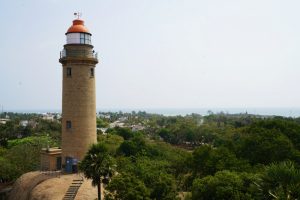 It was unbearably hot at 10:30 am. I returned to the hotel after having two dosa for breakfast (R100). At 12:30 pm, Muthu arranged an air-con minibus to take us to Chennai, 60km north of Mamallapuram.
It was unbearably hot at 10:30 am. I returned to the hotel after having two dosa for breakfast (R100). At 12:30 pm, Muthu arranged an air-con minibus to take us to Chennai, 60km north of Mamallapuram.
Chennai (known as Madras till 1996), is the state capital of Tamil Nadu. It is the sixth most populous city in India and the biggest cultural, economic and educational centre of South India. The Portuguese first arrived in 1522 AD and built a port called Sao Tome after St. Thomas, one of the 12 apostles who is believed to have preached in the area between 52 and 72 AD.
In 1639 AD, Francis Day of the East India Company succeeded in obtaining a lease of a strip of land about six miles long and one mile inland from Vijayanager Emperor Chennappa Nayakudu. The British built Fort St. George, the first major English settlement in India the following year. In 1746 AD, the fort and Madras were captured by the French. The British regained control in 1749 AD through the Treaty of Aix-la-Chapelle. By the 18th century, the British had conquered most of the region around Tamil Nadu and the northern modern states of Andhra Pradesh and Karnataka establishing the Madras Presidency with Madras as the capital.
Chennai is rich in colonial history and dotted with notable historical land marks. But as we had to catch an early evening train to Hyderabad, Muthu only arranged us to visit the St. Thomas Cathedral Basilica. According to legend, the saint arrived at Muziris in present-day Kerala state in 52 AD and was martyred on St. Thomas Mount twenty years later. First built in the 16th century by the Portuguese over the tomb of St. Thomas, it was rebuilt as a church with the status of a cathedral by the British in 1893 AD. I visited the International Shrine of St. Thomas which is underneath the basilica.
This church is one of the only three known churches in the world built over the tomb of an apostle. The others are St Peter’s Basilica in the Vatican City and Santiago de Compostela Cathedral in Spain. I feel blessed and privileged to have visited these three holy sites.
At our request, Muthu arranged a brief city tour with a stop at the expansive Marina Beach. We saw some historical buildings including the high court and the St. George Fort. We spent an hour in a new shopping mall where we all satisfied ourselves with comfort or junk food: a few bought sandwiches from Subway, one had a KFC combo and I had fried noodles.
 At 4:15 pm we departed for Chennai Central, the busiest railway station in South India and one of the most important hubs in India. As we had avoided the rush hours, we arrived at the station within 15 minutes! The red and white century-old building designed by architect George Harding, has apparently undergone a recent facelift. It is not too messy by Indian standards. But I find the smell of urine repugnant.
At 4:15 pm we departed for Chennai Central, the busiest railway station in South India and one of the most important hubs in India. As we had avoided the rush hours, we arrived at the station within 15 minutes! The red and white century-old building designed by architect George Harding, has apparently undergone a recent facelift. It is not too messy by Indian standards. But I find the smell of urine repugnant.
The Chennai – Hyderabad Express has 27 carriages. I slept in an upper bunk bed in a 2nd class A/C carriage. I must be tired. Though the bed was hard, uncomfortable and filthy, I slipped into my clean sleeping bag/sheet and managed to sleep on and off till 6 am.







